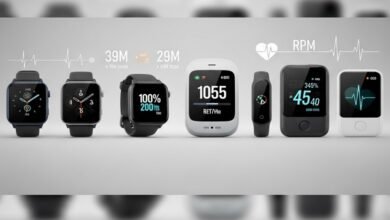The Rise of Wearable Health & RPM Devices in 2025
In 2025, wearable health devices and remote patient monitoring (RPM) technologies have become integral to modern healthcare. These innovations empower patients to manage chronic conditions, monitor vital signs, and engage in proactive health management—all from the comfort of their homes.
🔍 Key Trends Shaping Wearable Health & RPM Devices
1. AI-Powered Predictive Analytics
Artificial Intelligence (AI) is revolutionizing RPM by enabling devices to predict health events before they occur. For instance, AI algorithms analyze patterns in data from wearables to foresee potential complications in chronic conditions like diabetes or heart disease, allowing for timely interventions HealthSnap.
2. Integration with Telehealth Platforms
Modern wearables seamlessly integrate with telehealth platforms, facilitating real-time data sharing between patients and healthcare providers. This integration enhances remote consultations, enabling clinicians to make informed decisions based on up-to-date patient data iData Research.
3. Advanced Biometric Monitoring
Today’s wearables go beyond basic activity tracking. Devices now monitor a range of biomarkers, including blood oxygen levels, heart rate variability, and even stress indicators. This comprehensive monitoring provides a holistic view of an individual’s health TechInsights.
4. Enhanced Data Security
With the increasing amount of personal health data being generated, ensuring its security is paramount. Advanced encryption methods and secure data transmission protocols are being implemented to protect patient information and maintain privacy HealthArc.
🛠️ Top Wearable Health Devices in 2025
1. Samsung Galaxy Ring
The Samsung Galaxy Ring is a sleek, titanium-coated wearable that offers advanced health tracking features, including sleep monitoring, heart rate tracking, and activity logging. Notably, it does not require a subscription to access its full features, making it a cost-effective option for users New York Post.
2. Apple Watch Series 9
The Apple Watch Series 9 continues to be a leader in wearable health technology. It offers comprehensive health monitoring features such as ECG, blood oxygen measurement, and fall detection. Its seamless integration with the Apple ecosystem enhances user experience and accessibility.
3. Fitbit Charge 6
Fitbit’s Charge 6 provides robust fitness tracking capabilities along with health monitoring features like heart rate tracking and sleep analysis. Its user-friendly interface and long battery life make it a popular choice among health-conscious individuals.
🏥 RPM Devices Transforming Healthcare Delivery
1. Omron HeartGuide
The Omron HeartGuide is a clinically validated wearable blood pressure monitor that allows users to track their blood pressure throughout the day. Its compact design and accuracy make it a valuable tool for individuals managing hypertension.
2. Dexcom G7 Continuous Glucose Monitor
The Dexcom G7 is a state-of-the-art continuous glucose monitoring system that provides real-time glucose readings. It’s particularly beneficial for individuals with diabetes, offering insights into glucose trends and helping to manage insulin therapy effectively.
3. Masimo MightySat
Masimo’s MightySat is a fingertip pulse oximeter that measures blood oxygen saturation, pulse rate, and perfusion index. It’s a handy device for individuals with respiratory conditions, providing quick and accurate readings.
💡 The Future of Wearable Health & RPM Devices
Looking ahead, the future of wearable health and RPM devices is promising. Innovations in AI, machine learning, and sensor technology are expected to further enhance the capabilities of these devices. Future trends include:
- Personalized Health Insights: Advanced algorithms will provide users with tailored health recommendations based on their unique data profiles.
- Expanded Disease Monitoring: Wearables will monitor a broader range of health conditions, including mental health and neurological disorders.
- Improved Battery Life: Ongoing advancements will lead to longer battery life, reducing the need for frequent charging.
- Greater Accessibility: Efforts will be made to make these technologies more affordable and accessible to a wider population.
✅ Conclusion
Wearable health devices and RPM technologies are at the forefront of a healthcare revolution, offering individuals the tools to monitor and manage their health proactively. As technology continues to evolve, these devices will become even more integral to personalized healthcare, paving the way for a future where individuals have greater control over their health outcomes.



